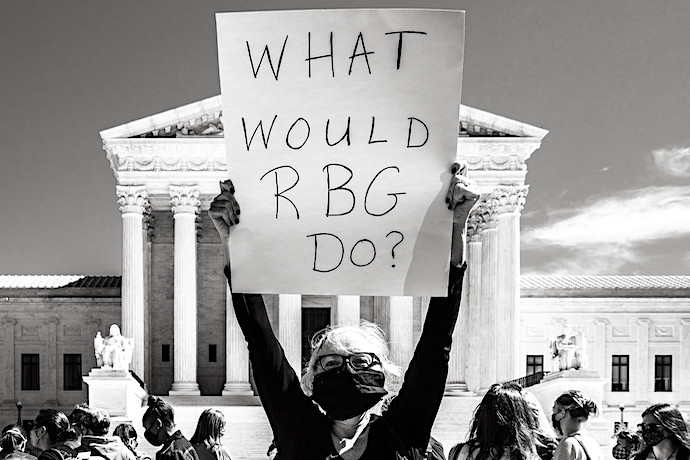Sixteen days before Ruth Bader Ginsburg died, the Supreme Court scheduled a conference on a case that could end the reproductive freedom of 170 million American women. Ginsburg died on Sept. 19, 2020, and the conference, set for Sept. 29, that would decide whether the high court would hear this pivotal case, was postponed. And then postponed again. After delaying and rescheduling more than 20 times, the Supreme Court decided Monday to take Dobbs v. Jackson Women’s Health Organization, a case out of Mississippi orchestrated specifically to challenge Roe v. Wade.
The chances that this challenge will be successful have dramatically increased now that Amy Coney Barrett has replaced RBG. It’s easy to imagine that the justices were waiting to see what would happen with the election and any possible new justice before taking the case, then giving it some space from Barrett’s confirmation. But Barrett was put on the court to write the opinion that overturns Roe, as many, myself included, warned after Barrett’s nomination. Christian Nationalist preacher, Fox News contributor, and Trump bootlicker Robert Jeffress was explicit on Fox the other night when discussing this case: “We’re gonna see now what the justices do and if they uphold their part of the deal.” This was “the deal.” Trump and McConnell put you on the court, you end Roe.
The point is to have a woman author the opinion that takes away all women’s reproductive rights. This gives Jeffress and white evangelicals—the only religious demographic in which a majority supports outlawing abortion—a simple counterargument that their audience will eat up: “How can the decision be anti-woman if it was written by a woman?!”
They’re gunning for Roe. And after that, they’re coming for contraception. If that sounds outlandish, remember how they attacked the Affordable Care Act. Remember the arguments they’ve used to redefine religious freedom. Remember the Hobby Lobby case. Look at the similarities between the chart above and public opinion on contraception.
The end of Roe may not be explicit. I wouldn’t be surprised if it is, but the smart money would be against the court saying, “We overturn Roe v. Wade,” and instead leaving the case in name only, so it can still be exploited as a rallying and donating cry for conservatives. The opinion will probably come down in June 2022, just before the mid-terms. Why take away that political motivator?
Plus, not expressly overturning Roe would also allow the court to maintain the pretense that it gives a fig about precedent. It doesn’t. Take, for example, the justice that now sits at the center of the court, Brett Kavanaugh. Since Barrett was confirmed, Kavanaugh has voted in the majority more than any other justice, 97 percent of the time. As Ian Millhiser put it over at Vox, “the Court’s new median justice really doesn’t care about precedent.” It’s not just Kavanaugh; all six conservative justices have been mowing down decades-old precedent by the score, but carefully pretending otherwise. This has implications that go well beyond reproductive justice.
Some of you might be thinking about Chief Justice Roberts, the occasional savior according to some narratives. You’re hoping that he’ll stop this. He’ll use his prerogative as Chief to write the majority opinion and mitigate the damage or do the right thing. Didn’t he try to stop this a little while ago about another case with abortion, something about June and medical services?
First, that case was decided before Roberts was outnumbered by conservative justices who want change now. Roberts is an incrementalist, but still deeply conservative. He wants to change things slowly to preserve the legitimacy of the court and its ability to move the country in line with his conservative ideology. But now there are five conservatives who don’t care, who, as we’ve just seen, are willing to overturn precedent that is decades, even centuries old, and pretend like they’re not. Roberts doesn’t have the votes to stop this—assuming he even wants to.
Second, yes, Roberts did the right thing in a June 2020 case involving a Louisiana restriction on abortion, June Medical Services. Roberts voted with the four liberals so the abortion law was struck down by a 5-4 vote. Roberts didn’t vote that way because of ideology, but because the court had decided a case on a nearly identical law (from Texas) in 2016. Roberts’s opinion in June Medical boiled down to Roberts saying, “Come on! We literally just decided this exact same case a few years ago. Give me any other targeted restriction on abortion providers and I’ll give you the decision you want, but I can’t overrule a decision from four years ago! Give me some cover.” That 2016 case was a 6-3 decision. Since it was decided, Trump dumped Gorsuch, Kavanaugh, and Barrett onto the Supreme Court. All are hostile to Roe. The court has been packed by McConnell, Trump, and the Federalist Society.
In the new abortion case, Jackson Women’s Health, this Supreme Court is going to rewrite women’s rights and allow states to limit reproductive freedom to the short time before most women even discover they’re pregnant. The court might even claim to be fighting for women’s health in the process, an absurd lie Jessica Valenti recently shredded in a New York Times editorial. The finer points of the law here don’t really matter because the court has already decided the case. (The restrictive Mississippi statute was based on model legislation written by the Alliance Defending Freedom, an anti-LGBTQ, Christian Nationalist legal outfit, which tells you all you need to know.)
Women are about to lose their bodily autonomy. Politicians will control their bodies because of five men and one woman on the high court. Contraception will be next. What can be done? Congress can and should step in and pass a federal law guaranteeing women’s right to an abortion. But that requires abolishing the filibuster. That also requires expanding and rebalancing the court. Because that federal law is going to be challenged. As would any solution.
When Roe was handed down in 1973, it was a landmark victory for women’s reproductive rights, but it didn’t immediately create the zealous blowback we see now. That moral outrage was manufactured by a group of white Christian men who longed for political power and chose to make abortion the issue of their retrogressive brand. But only after they had lost on segregation.
This vocal, power-hungry minority has pursued this path for decades. They’ve now seized control of the one body that doesn’t depend on the outcome of any election and which is immune to the demographic decline of their political power base. They’ve got a 6-3 majority on the Supreme Court that, from all angles, appears willing to protect and solidify this minority position against reproductive (and many other important) rights for decades to come.
Every possible solution to the danger this case poses to reproductive justice, to the danger this court poses for voting rights, racial justice, and genuine religious freedom (as opposed to the weaponized version we’ve seen lately) has the same prerequisite: expanding and rebalancing the Supreme Court. McConnell, the Federalist society, Trump, and the Christian nationalists have packed the Supreme Court, stealing seats to do so. The threat is very real and it won’t end with abortion. The time for court reform and expansion is now.





